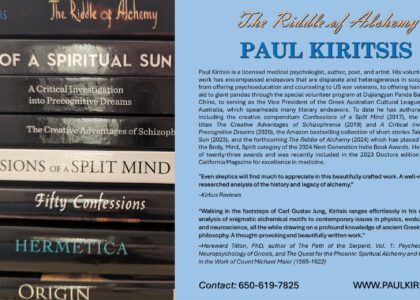
Calcinatio, the fourth phase of the therapeutic process, is primarily concerned with the unconditional acceptance of warring opposites within one’s psyche. Alchemy understands this procedural aspect of the Work as a chemical reduction of metals like copper and iron into granular powders, ashes, or dust. Writing specifically about this phase of alchemical transformation in his Philosophia maturata during the seventeenth century, Lancelot Colson (ca. 1627-1687) decreed that the prime or base substance to be worked on is “our Crows Bill, far blacker than Pitch, which thou may’st set on fire, by putting a kindled Cole into it; so as it should be calcined… into a most yellow Earth; But this Calcination sufficeth not for its perfect cleansing; put it therefore into a Reverberatory with a moderate heat, for eight dayes, and so many Nights following, increasing the heat and flame, till it be white as Snow.” The abovementioned statement draws our attention to calcinatio as an operation mediated by the fire element on unrefined, impure, or unalloyed metals and substances for the sake of exorcising any elementary components prone to volatization. Alchemical manuscripts of all ages have acknowledged and encrypted this phase into its hidden knowledge system using such vexing symbolic images as lions devouring suns, ravening wolves feasting on kings, and dragons engaged in autophagy. By far the most renowned treatise detailing aspects of this chemical, psychological, and cosmic drying-out phenomenon is Basil Valentine’s Twelve Keys.
The principles of calcinatio remain constant when transposed to the psychological level. If physical fire can reduce a metal or substance into a fine calx, then the ethereal fires of the heart that derive from concupiscence–from possessive love, lust, and desire–should also be able to perform analogous operations in the multidimensional psyche. The reality of the latter becomes blatantly obvious by following the trajectory of objective human consciousness as it descends to the realm of the unconscious and eventually overcomes desirousness birthed from the wellspring of pure instinctual urges. In the preceding therapeutic phase of separatio, we saw how even an equivocal awareness of warring opposite subselves within oneself promotes the maturation, development, and evolution of a mind that can rise above its own circle of egoistic projections and perceive the ruptures, aberrations, and omissions inherent to each corresponding set of opposites. Calcinatio is basically a concretization or coagulation of proliferating self-awareness attained in such a manner. Psychologically speaking fire is a by-product of one’s own mentation that spontaneously ignites when instinctual desirousness continues to proliferate unchecked until it floods the present ego-conscious in a pool of prodigious pretensions and illusory autonomy. Its potency is usually equivalent with the nature of the complex or disturbance as unearthed by the counsellor-client synergy. In layman’s terms we could say that the strength of an action spawns a reaction of the same kinetic force.
How these hermetic fires are produces isn’t all that hard to understand. Habitually what happens is that the incapability of the ego-self to contain shadows reverberating up from the transpersonal areas of the psyche frustrates it beyond reckoning, creating an inner friction whose subtle rubbing sparks the fires of dissolution to life. These spontaneous eruptions purge the ego of any identification with unruly emotions that might inflate it or encourage pride and leave behind only the charred ashes (thought-desires) compatible with transpersonal authority. Sometimes, the denied justifications leading to the reduction of ego consciousness into ‘white ashes’ and ‘white foliated earth’ occur within synthetically produced circumstances (counselling rooms) and at other times through more authentic channels. In this fashion a powerful essence is created that makes the psychic membrane of the present, self-conscious personality less permeable to emotional vibrations coming from within and without and concomitantly guards the individuating aspect of the soul from intense affect. The counsellors main task during this phase is to ensure that all telepathic or physical (dream or bodily) symptoms identified as deriving from frustrated desires that have produced neurosis or psychological disturbance are amplified using techniques sensitive to the client’s disposition and circumstances. In most cases, the likelihood of the schism being healed will rest on the shoulders of the mediating counsellor who must pertinently and correctly identify the symptomology of the underlying complex. Failure to make a positive identification at this stage may terminate transmutation of the inner and render the rest of the process defunct. Furthermore, if the relationship between counsellor and client isn’t bound by trust, empathy, and mutual respect by now, calcinatio can initiate a downward spiral into destructive negativity, paranoia, and in the worst case scenarios drive the client over the edge into madness.
Because this intermediary phase is somewhat concerned with an examination of the hierarchical order of the intellect, the emotions, and other forms of mentation that comprise consciousness there is always the risk that the whole therapist-client synergy–a dynamic system that has hitherto been operating smoothly and efficiently–might be subjected to scrutiny and re-evaluation. It is not uncommon for a client to witness cracks forming on the alchemical vessel, to experience doubts about his or her professional relationship and project them onto the mediating counsellor. Until now the latter has been perceived as a superior motherly figure with a soteriological function; to solve or help solve any psychological hindrance blocking pathways to freedom and tranquillity. But the eradication of preconceptions means that the perception of a good and nurturing mother figure can quickly become the terrible, cold-hearted one interested only in monetary gain. This flipping open of Pandora’s Box only complicates matters further and raises a great many more questions than it answers. Who is this person who feigns flawlessness? Why should I listen to or believe anything he or she says? What makes this person so qualified to speak about and untangle knots that he or she may also have become knotted in at some stage in life?
The best course of action that a therapist can take if a scenario of this sort comes to pass is to contain doubts and questions about motives in any way possible. Some of these are bound to strike inner keys and sound like emotional chords that intuitively speak to his or her own life myth. If such a scenario were to eventuate then the counsellor would do well to seek support and supervision with another counsellor who becomes a conduit through which accumulating emotional steam might be let out. Typically, suspicion projected onto the arbitrating counsellor in the form of questions and nagging doubts never seems to last all that long; I guess the client’s shifting inner perspectives are still quite protean in composition and just don’t allow protracted fixation of assumptions. An attack on the counsellor can quickly dematerialize and rematerialize as grovelling sentiments of sorrow and self-pity. A client might ask, “Why do you even counsel people for? What’s in it for you? Oh, hold on a second. I think I know why. It’s for the money. Why should you care about somebody you don’t even know from a bar of soap?” Conflicting feelings are bound to produce questions such as these and the best line of recourse for any mindful counsellor is to straddle the line between the personal and the professional. For the most part a response such as, “What we’ve been doing together in these sessions really means a lot of me and I would dearly like to continue until we get you back onto the path of your heart’s desire.” This statement is soothing, reassuring, and prevaricates the backlash that might come with verbal declarations of detachment or more intimate ones that flirt with the transgression of professional parameters.
In a much broader psychotherapeutic context calcinatio signals a gradual shift in the gravity of one’s consciousness. The many modifications that have been made to the inner composition of the present, self-conscious personality in the last few stages of transmutation are either changing the nature of the symptomology or eradicating it from the dreambody altogether. At this point the client might also experience a sense of satisfaction and achievement; the feeling that he or she has travelled far from the time origin (the beginning of the therapeutic process). Another good thing that usually materializes here is a lapse into a relaxed state of indifference to a persisting apprehension stemming from the fear that psychotherapy is not as operative and transformational as the faculty of psychology and its faithful army of adherents make it out to be. Instinct and passion have now been channelled into a psychic conduit and are being expressed through more constructive means. Psychospiritual potential is also in the process of becoming experience. Meanwhile concentration and continuous focus of the will are producing essence. The ‘white ashes’ are about to be blown about by the spiritual winds and engender deeper and higher phenomena that until now had been confined to the realm of potential like little sunflower seedlings.








